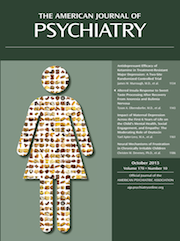Response to Learned Threat: An fMRI Study in Adolescent and Adult Anxiety
Abstract
Objective
Poor threat-safety discrimination reflects prefrontal cortex dysfunction in adult anxiety disorders. While adolescent anxiety disorders are impairing and predict high risk for adult anxiety disorders, the neural correlates of threat-safety discrimination have not been investigated in this population. The authors compared prefrontal cortex function in anxious and healthy adolescents and adults following conditioning and extinction, processes requiring threat-safety learning.
Method
Anxious and healthy adolescents and adults (N=114) completed fear conditioning and extinction in the clinic. The conditioned stimuli (CS+) were neutral faces, paired with an aversive scream. Physiological and subjective data were acquired. Three weeks later, 82 participants viewed the CS+ and morphed images resembling the CS+ in an MRI scanner. During scanning, participants made difficult threat-safety discriminations while appraising threat and explicit memory of the CS+.
Results
During conditioning and extinction, the anxious groups reported more fear than the healthy groups, but the anxious adolescent and adult groups did not differ on physiological measures. During imaging, both anxious adolescents and adults exhibited lower activation in the subgenual anterior cingulate cortex than their healthy counterparts, specifically when appraising threat. Compared with their age-matched counterpart groups, anxious adults exhibited reduced activation in the ventromedial prefrontal cortex when appraising threat, whereas anxious adolescents exhibited a U-shaped pattern of activation, with greater activation in response to the most extreme CS+ and CS–.
Conclusions
Two regions of the prefrontal cortex are involved in anxiety disorders. Reduced subgenual anterior cingulate cortex engagement is a shared feature in adult and adolescent anxiety disorders, but ventromedial prefrontal cortex dysfunction is age-specific. The unique U-shaped pattern of activation in the ventromedial prefrontal cortex in many anxious adolescents may reflect heightened sensitivity to threat and safety conditions. How variations in the pattern relate to later risk for adult illness remains to be determined.



